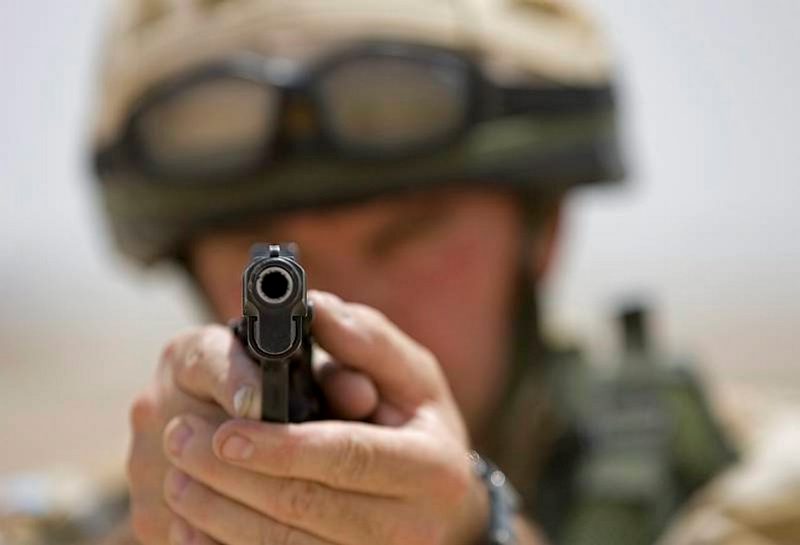Last January, after an extensive period of testing, the British Army announced that their venerable Browning Hi-Power Mk III pistols would be replaced with modern Glock 17 Generation 4 pistols, as a result of hard-won, on-the-ground, operational experience. Many observers of military affairs have been waiting in anticipation for a similar announcement from the ADF, which is also equipped with the FN Herstal Browning Hi-Power Mk III (or the ‘Self-Loading Pistol 9 millimeter Mark 3’ in ADF parlance). However, a year later, no such announcement has been forthcoming and there haven’t been any indications from Defence circles of a change in policy in the foreseeable future. This is an ethics issue.
The state has a clear duty of care to ensure that its armed servants are as well equipped as possible to face the dangers of combat and prevail over their adversaries. On the whole, the ADF goes to considerable lengths to fulfil that duty of care, from equipping frontline troops with quality armoured personnel carriers, to ensuring top-notch medical treatment for those injured in the line of duty. But there’s a blind spot when it comes to handguns. Outside of the special forces community, very few members of the ADF are issued with pistols, and most of them are in support rather than direct combat roles. Contrast this with the British Army’s commitment to rushing its newly-acquired Glock pistols to its frontline units deployed in Afghanistan, where pistols have been credited with saving the lives of several soldiers.
The Browning Hi-Power is unquestionably a fine weapon, much loved by connoisseurs of guns. But the undeniable fact is that it’s an antique, one that first entered military service in 1935. For all of the unquestionable genius of John Moses Browning’s classic creation, it’d be foolishness to think that the intervening eighty years haven’t seen improvements in handgun design.
Consider the Glock, for example. The Glock 17 has earned a reputation as the ‘Kalashnikov’ of handguns, a reference to its mechanical simplicity and unquestionable reliability under extreme conditions. It’s 30% lighter than the Hi-Power—and that’s with a magazine loaded with 17 9mm rounds compared to the Hi-Power’s maximum of 13. Obviously in circumstances that require the employment of a handgun it’s better to have 17 ‘on board’ than 13—even the quickest magazine change can’t compete with simply pressing the trigger to send that 14th round on its way. The striker-fired Glock 17 can be safely carried with a round in the chamber and doesn’t require an external safety catch to be disengaged before firing. British Army tests suggested that a Glock 17 can be drawn and fired in under a second, while engaging a target with the Browning could take ‘four seconds or more’. The Glock is also significantly cheaper per unit than the Browning.
My point isn’t to push for the Glock 17 as the replacement for the ADF’s Hi-Power pistols. The Glock is itself a 30-year-old design, and there are more recent designs that are also worthy of consideration. Whatever successor is chosen, it must come alongside recognition of the need to issue it across the force and train personnel accordingly.
In a recent conversation I had with a SASR operator he referred to his handgun as being like a back-up parachute; likewise British troops in Helmand referred to theirs as ‘lifesavers’. Hard-won experience has shown that when the magazine of a soldier’s primary weapon runs empty they can transition to a pistol quicker than they can load another primary magazine, and the time advantage over trying to clear a stoppage before re-engaging is significant. Those seconds could represent the difference between life and death. And in circumstances where it’s awkward or inappropriate to carry a rifle (such as when training host nation forces), a handgun on the hip offers a last-ditch defence against unexpected and much feared, ‘green-on-blue’ attacks. Furthermore, in close confines a pistol can often be brought to bear as the ‘primary’ more easily than a long gun, in a way that requires operators to expose themselves less to enemy fire. In the case of the ADF, this need is intensified by the difficulty of effectively employing the F88 Austeyr (the ADF’s primary infantry weapon) from the operator’s weak shoulder during cornering drills (also, in my view, ethically problematic).
The current ADF handgun belongs to an era when bolt-action rifles were king of the battlefield. We wouldn’t send our troops into harm’s way with a .303 Lee Enfield rifle today, so why do we send them out with vintage handguns—or none at all?
Deane-Peter Baker is a lecturer in the School of Humanities and Social Sciences at the University of New South Wales, Canberra. Image courtesy of UK Ministry of Defence.


